- Act 1: The Hard Sell — our path to launching AirDev
- Act 2: Talk Nerdy to Me — Bubble as a disruptive technology
- Act 3: Back to the Future — five predictions for web development
Introduction
This is not an article about Silicon Valley. I don’t purport to know whether its frothy valuations are justified, nor whether its tech-obsessed cultural oddities (evidenced here) are enlightened or misguided. This is, however, an article about technological change. So perhaps it is fitting that the story begins with the 60-mile stretch along Highway 101 that houses more than a third of today’s unicorns and VC money worldwide. Strong forces preserve the Valley’s position as the global epicenter for innovation and creativity. YCombinator boss Sam Altman describes the secret sauce in his blog post, Why Silicon Valley Works, as a powerful and self-reinforcing network, a cauldron of ideas, talent, and funding that is constantly spinning insight into impact. Each ingredient attracts the others, and the gravitational pull intensifies as the network concentrates. Which begs the question: what type of force might threaten such an ecosystem?
As long as the rules of the game remain the same — that ideas require expensive technical specialists to grow — the Valley’s inimitable network will protect its reign. But what if those rules changed? Enter Bubble, a powerful new tool built 3,000 miles away, which offers a vision for what this future may look like. Bubble is an all-purpose web-building platform that turns the everyday hack into a full-stack hacker. Woebegones become Wozniaks. Suckers become Zuckerbergs. Truth be told, the vision of a democratization of code has been around for quite some time, and has endured a number of false starts. Three factors lead me to believe the latest incarnation will stick:
- First, today’s solutions are more powerful and simpler to operate, backed by virtual servers and connected to countless API web services;
- Second, the appetite for such tools is insatiable given the dramatic mismatch between developer supply and demand;
- Third, I have lived the transformation myself, becoming a professional web developer without having learned any code.
In this article, I tell the story of how and why my cofounder, Vlad, and I quit our jobs to launch a new approach to web development, AirDev. I close with a few foolhardy predictions for where a post-code future may take us.

Act 1: The Hard Sell
The requirements have been documented, the wireframes drawn up. The calendar has been filled with colorful scribbles marking deadlines, testing periods, and review cycles. Then comes the inevitable question:
“So, where are your developers based?”
We take a short uncomfortable glance at one another, because as many times as we have been asked to explain how we build software at AirDev, we have not yet found the magic one-liner to put our clients at ease. The rest of the conversation follows a predictable sequence:
“Well, we actually do all the development ourselves.”
“Oh that’s great. What languages do you code in?”
“Um, we don’t actually ‘code’ per se. We create sites using a visual programming interface, which allows us to build really fast.”
“Oh, like Squarespace? But wait, we’ve just spec’d out a completely customized site with two user types, commercial transactions, API integrations, and direct messaging. Squarespace can’t do that, can it?”
“No…have you heard of Bubble?”
This year, the two of us (Andrew Haller and Vlad Leytus) quit our post-MBA jobs in management consulting and analytics to start a new kind of web development agency, because we believe that the way software is built — and who builds it — will undergo a fundamental change over the next five to ten years. We hope to prove the case and lead the movement.
Prior to 2013, we had a grand total of zero programming experience between us. Perhaps that is not entirely fair; Vlad had engineered a few macros in Excel, and I had built a program on my TI-83 calculator to solve quadratic equations. But, while we could dazzle you with Powerpoint slides and financial models, the web was strictly out of our domain.

And yet, when we met one another at Harvard Business School, we were each attempting to launch a tech-enabled startup as a non-technical founder. I was working on a platform where emerging music artists could book crowd-funded private concerts, and Vlad was creating a social network for people to share resources within communities. The problem we encountered is that software (even the simple, minimum-viable-product kind) is hard to come by. We tried all the common approaches, to no avail:
- oDesk freelancers required specifications to the umpteenth detailed dimension, and often delivered behind schedule and over budget;
- Professional design shops were prohibitively expensive, charging $50K for a “concept”;
- Genius technical cofounders were not interested in speaking with MBA-types, and wanted 50% of the business as a starting point;
- Hacking together basic HTML to email data to an Excel sheet was… crappy.
With no other options in sight, I was thrilled when I found a link buried in the bottom of a school newsletter referencing a new DIY tool for making websites. I also happened to be the only student without the common sense to be skeptical of yet another web-builder tool claiming to be the panacea for development woes. I met with Bubble co-founders Josh Haas and Emmanuel Straschnov in an open meeting room on campus, and heard about their young product and vision: what if everyone was empowered to build websites, and true coders could focus on not-yet-solved computer science problems? Though such a future seemed mildly amusing, at the time I was most excited to take control of my own site using Bubble.
Within a few months, I had learned the basic Bubble interface, sent scores of new feature requests to Josh and Emmanuel, ran my 2007 MacBook into the ground, and built a functional MVP for my business, Ripple Concerts. The product included separate account types for artists and fans, the ability to create and crowdfund concerts, and integration with Stripe to manage payments. It wasn’t flashy by today’s standards, but it was a far cry from the days of the TI-83.
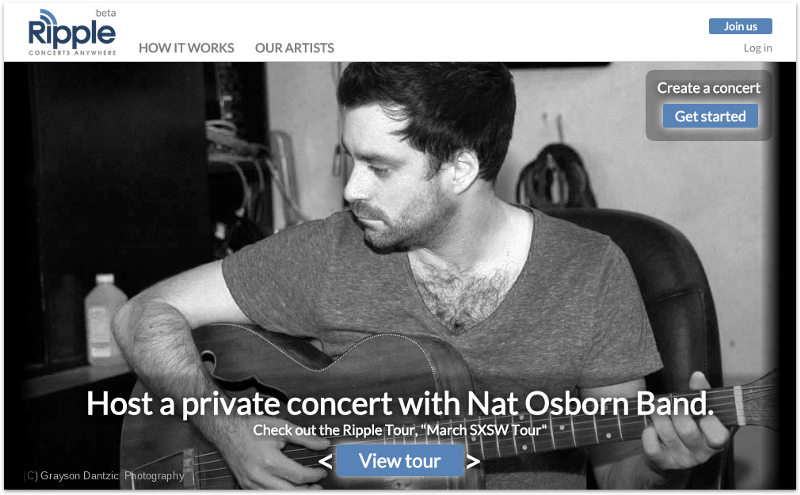
When I shared my experience with Vlad, he jumped on board and within a month had learned the tool and built his social sharing platform, KindThread. His confidence may have lagged his proficiency, as he included a message directly on the landing page asking users to email him if they encountered any bugs.
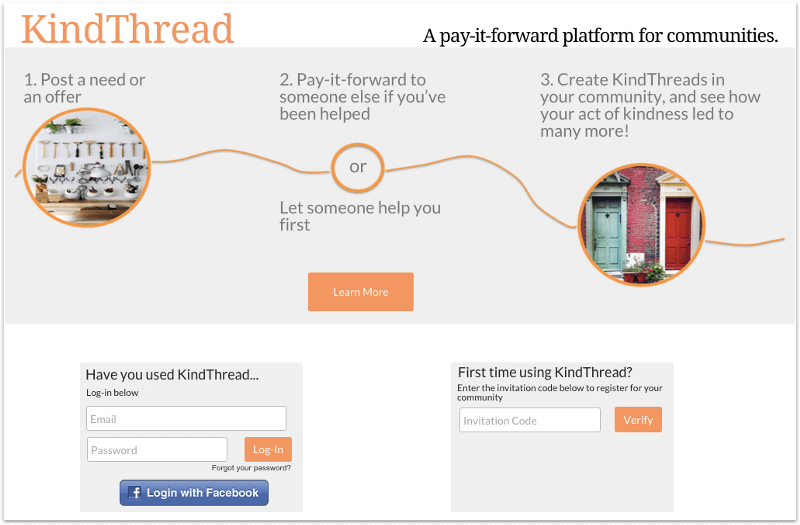
After a few months working in Bubble, we experienced a curious phenomenon. Not only were we now able to create the web applications we had imagined, but we found the building process to be the most invigorating and downright addictive part of running our companies. We caught ourselves putting off important business tasks to add “nice-to-have” features to our apps. Recognizing this new passion, we began to shift our focus away from our original ventures, and toward building apps. We took our newfound “coding” skills to the halls of HBS, designing sites for friends and classmates for nominal fees.
Even after graduation, as we set out to resume our careers in strategy and analytics, we continued to dabble in freelance work on the side, refining our skills for rapid and real web development. This process reached its apex when, on a Saturday afternoon in San Francisco, Vlad showed me Not Real Twitter. He explained that he had painstakingly toggled between two tabs on his browser, Twitter and the Bubble editor, matching every key feature, function, and design element on the site — in just four days (learn more here). The following week, we posted Not Real Twitter on Hacker News, and received lots of positive, dismissive, and occasionally hilarious feedback. Here are a few of our favorite Not-Real-Tweets from the site itself:
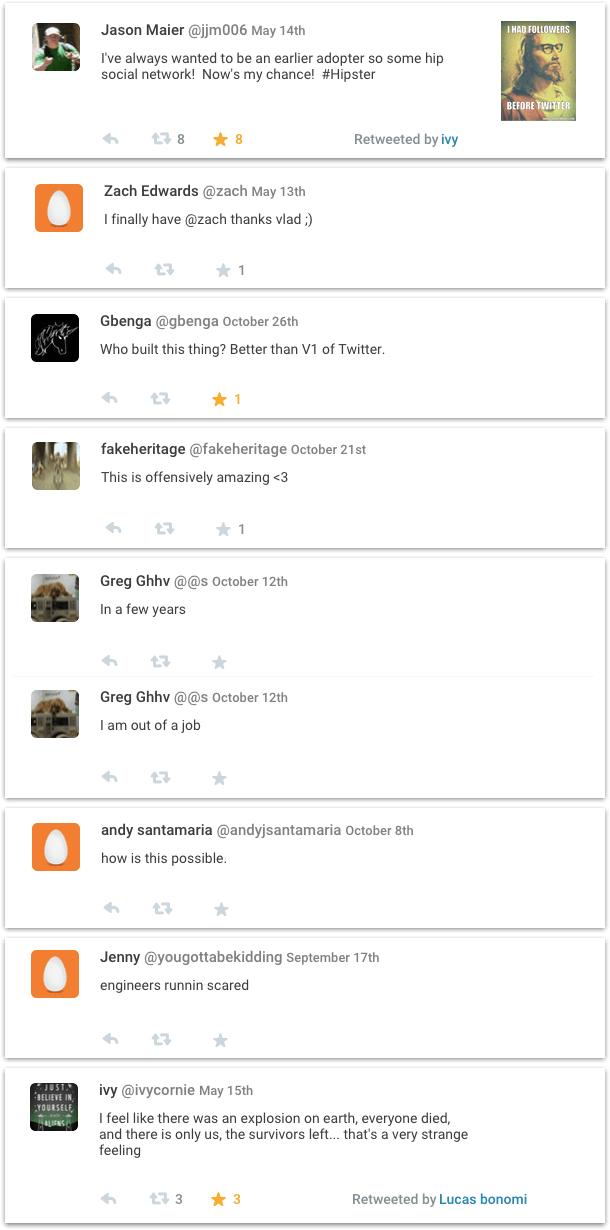
This was the proof we needed that we could compete in the “real world” of software development, producing beautiful and fully functional tools in a fraction of the time of traditional shops. We filed the paperwork, and AirDev was officially launched.
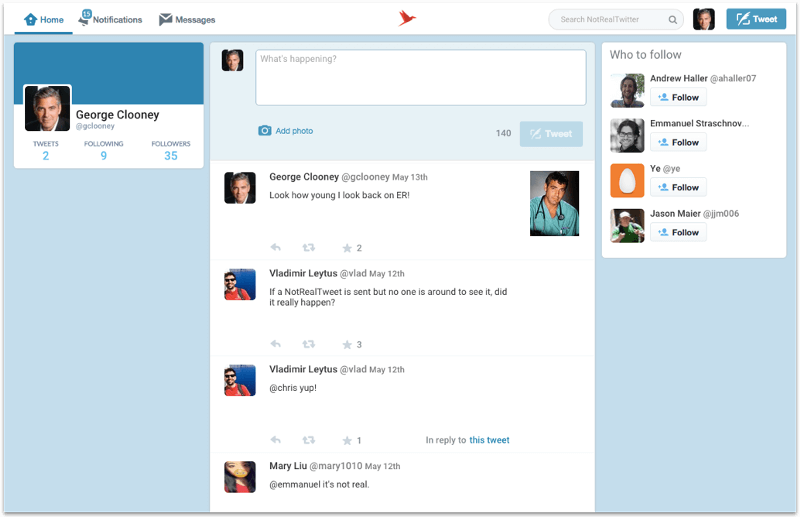
Act 2: Talk Nerdy to Me
Bubble is a powerful platform, but it can’t do everything… yet. As I write this post, Bubble web apps do not feature fully responsive design, are limited in the types of animations they support, and don’t yet integrate with every API out there (and there are a lot). Mobile apps cannot send push notifications or access a phone’s Bluetooth. Some customers are frustrated when they hit these limitations, but the reason we have invested our careers in the tool’s success is because all its constraints are temporary. Bubble is a classic “disruptive” technology.
And now for an academic digression…
When we were growing up, “disruption” was something you were sent to the principal’s office for. Now it is a badge of honor and the aspiration of every self-respecting startup — Uber is disrupting taxis, Airbnb is disrupting hotels, and Jet is disrupting Amazon, which is disrupting Walmart, which is disrupting your uncle’s corner store. Why is being a business bully now the most popular profession on the market, and the art of billionaires?
“Disruption” today is shorthand for the term “disruptive innovation”, coined by HBS Professor Clayton Christensen and described in his classic bestseller, The Innovator’s Dilemma. In fact, the “innovation” part is what drives the real value, and “disruption” is the regrettable collateral damage in the process. Semantics aside, there is real academic theory behind the process of disruptive innovation, which goes something like the following:
- A new technology (cell phones, digital photos, or Google Docs) emerges that is able to serve an existing function at a dramatically lower cost base than the traditional approach; however, its quality is inferior at first (crackly calls, grainy images, no page breaks).
- The industry leader (the “incumbent”) takes one look at the challenge from the new technology (the “upstart”) and dismisses it outright, noting that it is happy to part with its least profitable customers to focus on its premium products, where the margins are fat.
- However, there is a catch, a fatal flaw in this logic, which is the crux of the theory: technology always improves at a faster rate than customer needs. This means that before long, the upstart has improved its quality to be “good enough” to compete at the next level, where the incumbent once again happily surrenders its least profitable segment. This process repeats until the upstart has captured all but the very highest of premium customers, where the old incumbent remains in a “defensive crouch” as the world has left it behind.
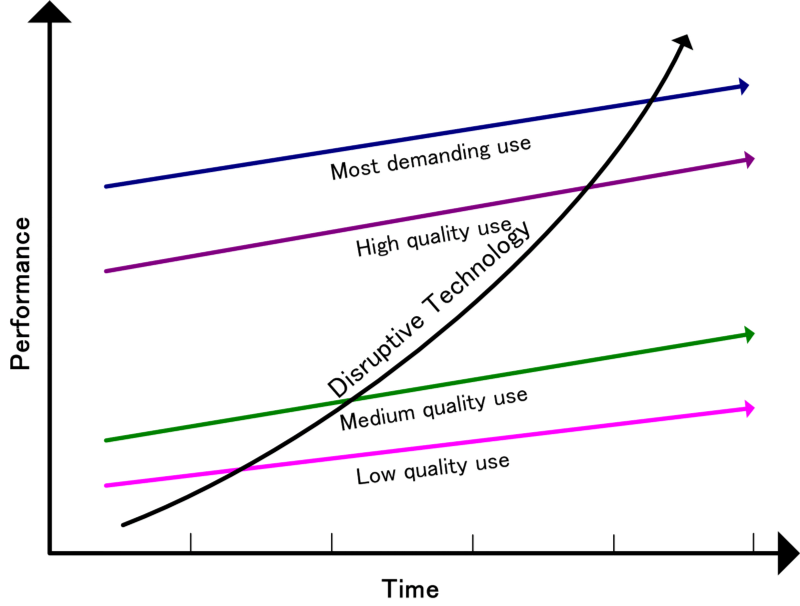
If you stack today’s “disruptive” darlings against this theory, several notable superstars do not fit the bill. Christensen argued earlier this year that Tesla is not disrupting the car industry, as they have targeted the premium end of the market with greater performance and style at a higher price. Just this month, he added Uber to the list of non-disruptors, citing that its ride-hailing app has gained its mainstream foothold by offering convenience and a superior experience relative to taxis. Indeed, the incumbent car and taxi companies have not demonstrated the “asymmetric motivation” predicted by Christensen’s theory. Instead of dismissing the new entrants, luxury car companies have rushed to release electric Tesla copycats, and taxi interest groups have fought to ban or restrict Uber’s presence at every turn.
Bubble, on the other hand, is a disruptive technology in the classic sense. Josh and Emmanuel have built a tool that has allowed our AirDev business to achieve a significantly lower cost base than our competition, in three ways:
- We can train our own staff rather than hiring expensive software engineers, relieving supply pressure that drives hourly rates up;
- We can reduce the number of separate perspectives (design, front-end, back-end), and the associated overhead cost to coordinate them;
- We can build up to 4x more in a given hour than a traditional developer, reducing the total number of hours required for a given project.
In addition to the lower cost base that is emblematic of disruptive technologies, Bubble has also demonstrated the ability to improve faster than customer demand, becoming “good enough” for new segments over time. When we started building with Bubble in 2013, it had quite significant limitations. You could not store data as a geographic location on a map, or as a date. You could not create complex references (e.g., a tweet’s user’s name). You could not set boxes to expand and contract to fit the text within them, or scroll within a list of records with your mouse. As students without funding or income, we represented the lowest end of the market, and were happy to hack our way around these constraints to get a prototype together, but no legitimate startup would have invested in a tool built on Bubble.
The original Bubble interface
In just two short years, all of these limitations have been solved, and many new features have been added to the platform. You can create beautiful and engaging graphic interfaces, maintain mobile-friendly versions of apps, edit your database directly from an admin portal, and integrate with dozens of APIs to do everything from monitoring user activity to sending text notifications, performing natural language processing, even embedding gifs (seriously, what’s with all the gifs? — a question for another time).
Over this same period, much less has changed in what users expect from their web applications (Airbnb got a facelift and video backgrounds became fashionable), and so Bubble has become capable of supporting products with large user bases and sophisticated requirements. This closing of the quality gap as technology outpaces customer needs is precisely the process that Christensen describes, and it is the path Bubble pursues. Theory would predict that this is a formula for success, but time will tell.
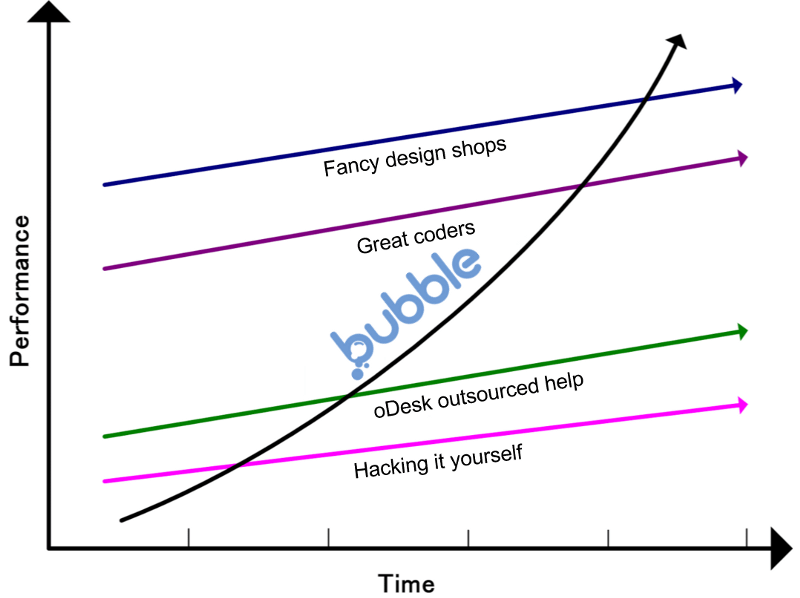
Act 3: Back to the Future
Speaking of time, to this point I have been focused on the “then” and “now”, while tiptoeing around big predictions for the future. But of course, the size of the opportunity in a tool like Bubble depends on how it might shape the world of programming in the coming decade. Let’s take a swing at that here.
In 2011 Marc Andreessen published his iconic article, Why Software is Eating the World. Three years later, Chris Dixon followed with a blog post entitled Software Eats Software Development, describing the various ways in which new software tools are making it cheaper and easier for entrepreneurs to bypass the typical process of hiring expensive developers to build and maintain technology. Dixon lists several examples of tools in each of his categories (e.g., cloud computing, APIs, specialized web-builders), but in the last, which he calls “general-purpose tools for non-programmers”, he instead issues a sort of challenge:
“In the pre-Internet era, tools like Hypercard and Visual Basic allowed hundreds of millions of semi-technical people to become software developers. Since then, there hasn’t been much work in these areas, but from what I’ve seen that might change soon. By allowing more people to program, these tools act as a force multiplier for the software industry.”
Vlad and I see Bubble as the answer to Dixon’s challenge, a tool that makes it possible for someone without any coding experience to build something real that works. We also see this “general-purpose” category as the most important of all, because it can act as the integrator of all the rest. As Bubble continues to improve its muscle and connectivity with the many tools and services making life easier for entrepreneurs, we predict five trends will reshape web development for the better:
(1) An explosion of micro-apps to solve business and personal tasks, greatly expanding the market for software
Today, the cost and time required to create custom software limits its usefulness to only the most critical commercial endeavors. When the process becomes cheap and quick, it opens up an enormous range of “long-tail” applications, both personal and professional. High schoolers will build apps to track pickup basketball stats. Young lovebirds will create vendor management systems for their upcoming nuptials. Busy parents will set up a self-serve chore checklist platform (complete with automatic allowance disbursement). Small business owners will ditch the spreadsheets to manage inventory and payroll on software built specifically for their needs. Companies will dump the five-year IT roadmap for a BYOS (bring-your-own-software) approach, empowering managers to design tools for their teams and projects. All of these cases will mark an expansion of web software into the nooks and crannies of productivity today held off-limits by cost barriers.
(2) An influx of talent and drop in price for basic technical development, resulting in a shift in the balance of power toward business and art
Christensen’s theory predicts that each time the upstart technology reaches a new quality threshold, the incumbent retreats and the price for that product drops significantly. Today college graduates with freshly minted CS degrees can earn $125K in their first year at Google or Facebook, and Bay Area helicopter parents are rushing to buy their infants toys to teach them to code. A tool like Bubble instantly changes the game, empowering individuals from all walks of life to enter the fray and build software professionally. This mass migration, and the new talent models that will result, will drive the cost of production down (as it has for AirDev), and flip the current model on its head. While YCombinator today trains technical prodigies on the art of business, we may soon see accelerators cultivating artists, financial analysts, teachers, and nurses with deep industry experience to build what they (and others like them) need.
(3) Greater investment in the big computer science problems, rather than cat apps
What about those poor CS majors? Will they be discarded by their employers, left to roam the streets, littering a trail of solved Rubik’s Cubes in their wake as they pass the fancy brunch establishments they used to frequent? We predict a more optimistic future — those with unique talent and expertise in computer science, no longer tempted by the instant riches of replicating existing technology for the next marketplace or social app, will instead turn to solving the important challenges in their field. There will always be a need for more efficient algorithms, more sophisticated machine learning, and creepier artificial intelligence. These are the types of challenges our best and brightest CS minds should be focusing on, providing for a rising tide that lifts all ships. With a tool like Bubble to simplify the easy stuff, we expect to see a greater investment in forwarding the foundational progress we can all benefit from.
Cat apps for all?
(4) More tools to benefit the not-super-rich
Earlier this year, the New York Times ran an article on Silicon Valley’s current upswing, entitled A Tech Boom Aimed at the Few, Instead of the World. Living in San Francisco, we are bombarded with a plethora of tech-enabled personal services targeting privileged young urban professionals with disposable income. Need to get somewhere? Tap Uber or Lyft. Hungry? Call up a meal from DoorDash or Caviar. Chores getting you down? Outsource to Handy or Alfred. Hosting a killer rooftop party with all your plaided friends? Order beer and condoms from Drizly and LCondoms, respectively. Did you wee your pants in excitement over the modern luxury now literally at your fingertips? Send them to Washio. When developers are the ones uniquely positioned to launch a technical venture, it is no wonder their bright ideas tend to solve the problems they face. Through low-cost technology like Bubble, one might expect new tools to spring up to solve problems in every community and income bracket globally, serving to level the playing field.
A revealing parody — everyone deserves empowerment
(5) A seamlessly integrated API web ecosystem
The last decade has seen an explosion in the number of Application Programming Interfaces (APIs) in circulation. APIs are small pieces of software that connect services to the outside world, so they can be linked to other tools and built upon by others. Today there are APIs for just about anything: I can use Stripe for payments, Google Maps for places, Facebook for identity, Twilio for communications, and a combination of Yodaspeak and Thankster if send a handwritten thank-you letter in backward syntax I must. And it gets even better when you layer on APIs-of-APIs like Zapier and Blockspring, which allow you to use logic (rather than code) to trigger other services. What is still missing amidst this flurry of API activity is an underlying layer that allows individuals to access and integrate various tools without needing to know code. Bubble’s goal is to become that layer, and if they succeed, they will extend not only the reach of the magical world of software development, but also of the many individual tools and services currently trapped in the exclusive world of code.
As the old adage goes, “predicting the future is easy … getting it right is the hard part.” Just ask Steve Ballmer (the iPhone will fail), Robert Metcalfe (the internet will collapse), or Steve Jobs (music subscriptions are bankrupt). There is a lot that can go wrong with the version of the world I lay out here. It may be that Bubble is ousted by a superior technology or sales force, or that it succeeds but scarcely affects the labor pool for technical talent. In fact, there are so many conditions and interactions and overlaps that it might seem entirely futile to make any predictions at all. But I must, and so must everyone. Whether you are starting a company, joining a movement, or taking a steady job at a law firm, you are placing a bet on what the state of the world will look like during your lifetime. Is it worth teaching your two-year-old to code? It seems like a surefire way to give them a leg up in today’s market, but they won’t compete in today’s market (that would be illegal child labor); they will compete in the market that exists 20 years from now. So Vlad and I have placed our career bets on a movement toward a post-code world, where ideas, storytelling, and hard-nosed execution rule. What will your bet be?
Learn more about what we’re up to at airdev.co
Build for as long as you want on the Free plan. Only upgrade when you're ready to launch.
Join Bubble







